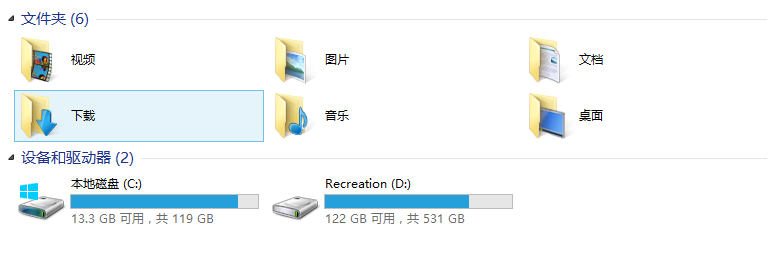As I watched the number of files on my computer grow and their storage become increasingly disorganized, how to organize them became a major problem. It was time to spend some effort tidying things up.
Disk Partitioning
My computer has two hard drives: a 128GB SSD and a 650GB HDD, configured as C: and D: drives respectively. Specifically:
- C: drive: For installing the operating system and all application software.
- D: drive: For storing data, including documents, music, movies, etc.
Why not set up multiple partitions like E:, F:, etc.? Because multiple partitions can lead to wasted space. For example: Suppose you have a 600GB hard drive divided into three partitions: C:, D:, and E:, with C: at 100GB, D: at 200GB, and E: at 300GB. Now, C: has 95GB used, D: has 198GB used, and E: has 287GB used. If you have a 20GB file, where would you put it? C:, D:, or E:? Nowhere. But you clearly have 600GB of space, and you’ve only used 580GB, leaving 20GB free. Yet, there’s no single place to put it. This is the space wasted by multiple partitions. Therefore, to maximize space utilization, it’s best to have the fewest possible partitions. Ideally, having just one C: drive would be enough. However, sometimes system issues require formatting the C: drive, and without a backup, this would lead to data loss. So, as a compromise, dividing it into two drives is a balanced approach.
File Management
Now that partitioning is settled, how should files be stored? Should they be stored by file type, or by file function?
Storing by File Type
Putting all music files in one folder, all movies in another, all documents in yet another…
At first glance, this seems fine, but sometimes conflicts arise. For example, if all documents are in one folder, work, study, and entertainment documents are all mixed together, it can still be troublesome to find a specific file. Some might say, “I’ll just use search.” Using search is a good method, but it requires you to know the name of the file you’re looking for. Unless you have excellent file naming habits, such as ‘project A - branch B - file C’, then search is a very effective method (for instance, Everything has incredibly fast search speeds). So, if you don’t have good naming habits, storing by file type won’t work.
Storing by File Function
First, categorize files into four main types:
- Work
- Life
- Study
- Backup
Then, within these categories, further subdivide them by their specific function. All work-related items go into the ‘Work’ category, other study materials unrelated to work go into ‘Study’, and other items like music, movies, and pictures belong to ‘Life’. Then, under each major category, further subdivide them by their respective functions, similar to a recursive approach. Finally, regularly update important items to the ‘Backup’ category, to facilitate easy copying and duplication.
My Classification System
My final classification system is shown below: 
 Am I perhaps using my C: drive a bit too aggressively? *^_^*
Am I perhaps using my C: drive a bit too aggressively? *^_^*
